
VOLKSWAGEN Polo 3 Doors
Generations Timeline, Specs and Pictures
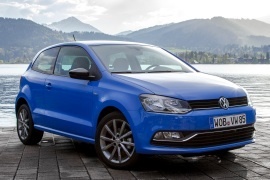
The fifth generation of the Volkswagen Polo was launched in 2009 and, five years later, it received a facelift to refresh its image on the market.
The fifth generation of Polo was elected the “2010 Car of the Year” in Europe and that well-deserved award was an acknowledgment of over 14 million units sold worldwide by its all generations, since 1975. In 2014, the car was refreshed both in the interior and on the exterior.
The 5-door version of the Polo from 2014 received a new front fascia, with a headlight design that was inspired by the Scirocco. A new design for the front bumper showed a wider grille on the apron, plus a longer lip underneath, that had an interesting role in pedestrian protection more than for an aerodynamic use.
Inside, the whole range received a touch-screen infotainment system installed on the center stack. It was a new idea for the small-segment, where the car was placed. The access to the five passengers was easy thanks to the four side doors. There was a decent room inside, even for three passengers on the bench seat. The split-fold bench’s seatback was standard.
The car was fitted with a wide choice of engine, both diesel and gasoline-powered units. For some versions, the standard transmission was 5-speed manual while for others was a 6-speed manual. A DSG gearbox was on the options list for both diesel or gasoline units.
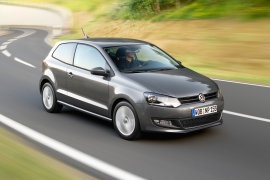
The fifth generation of the Polo was released in 2009 at the Geneva Motor Show, and it was just one inch shorter than the second generation of the Volkswagen Golf.
By the fifth Polo, Volkswagen already understood that it had to make it full-scale with all the body versions available when it introduces a new generation. Maybe it didn’t have all the engines or transmissions, but at least it had to show the 3- and the 5-door version for the little Polo.
It was a significant step from the design point of view with angular lines and a sporty-looking front fascia. The angled headlights and wide grille in the lower side of the bumper inspired a sporty sensation. The three-door version featured a slightly ascending window line and fixed windows in the back. Volkswagen considered that the pop-out, front-hinged windows were useless for the rear passengers but very annoying for those in the front seats.
Inside, the 3-door Polo offered bucket seats at the front with a center console between them that sported the gear-stick and the hand-brake. Its dashboard was typical for a Volkswagen, with rounded edges, soft materials, and a center stack for the infotainment system and the climate control unit. In the instrument cluster, the Polo designers installed a TFT display between the speedometer and tachometer and deleted the fuel-level and the coolant-temperature gauges. In the back, the split-folding (60:40) bench was fitted as standard.
Under the hood, Volkswagen installed an extensive range of diesel and gasoline engines ranged between 60 hp and 105 hp. The Polo GTI was a different story.
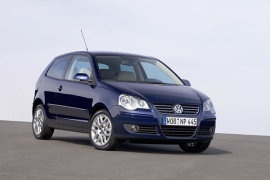
In 2005, all the European carmakers had to switch to Euro 4 emission standards, and Volkswagen improved its entire lineup, including the three-door Polo.
Slightly larger than the Golf’s first generation, the three-door Polo was a solution for crowded cities. It relied on the PQ24 platform, which it shared with the Seat Ibiza and the Skoda Fabia, to name just a few. But it wasn’t a cheap car anymore. It was still economical, but not cheap. Sometimes it needs a trained eye to see the differences between a facelifted and a non-facelifted version of a car. Not in this case. The 2005 Polo (Typ 9N3) dropped the Lupo-like dual round headlights favoring the style from the EOS coupe-cabriolet. Their outer side was rounded and emerged into a narrower, angular-shaped inner side. From its side, it revealed the turn signals enclosed in the door mirrors, a first for the Polo range. The rear side windows were wide and fixed, but most versions featured a standard air-conditioning unit.
Inside, the carmaker made less visible changes, depending on the options, but increased the materials’ quality and introduced new steering wheels and gear-knobs. The infotainment unit was enhanced and offered Bluetooth connectivity and a navigation system, depending on the options. There were new, sport-inspired steering wheels available, with three spokes. Its three-door version was fit for those who didn’t need the back seats other than short trips, but its split-folding rear bench expanded the trunk space from 270 liters (9.5 cu-ft) to 1,030 liters (36.4 cu-ft).
Under the hood, the carmaker offered a very wide engine choice, starting with a refreshed 1.2-liter gasoline engine and ending with a punchy, 1.9-liter 130 hp turbo-diesel unit. Depending on the options, it was available with a five- or six-speed manual or automatic transmission.

In 2001, Volkswagen introduced the fourth generation of its small-sized contender, the Polo.
And it wasn’t that small anymore.
The 2001 Polo was bigger than its predecessor. It was longer even than the first generation of its bigger sibling, the Volkswagen Golf. The increase in size and features made the little Polo a better alternative for other established compact-segment vehicles. Volkswagen installed a wide choice of safety features, which were not even available for other cars from Polo’s segment.
From the front, the Polo resembled the look of the new, smallest, Volkswagen Lupo with four round headlamps at the front. A black grille took an imposing position between them and gave the car a friendly look. The designers stated that they design a car to look happy, so the potential customers will smile when they see it.
Inside, the Polo featured a long list of equipment types, either standard or from the options list. The air-conditioning unit was fitted as standard on the higher trim levels. There were a few options for the seats, starting with plain bucket seats and ending with a pair of sport-bucket ones for the Polo GT. The sportiest version, named GTI, was available only on the three-door version.
The small Polo came with an extensive list of available engines with power ranging between 55 to 115 hp.

The 1999 Polo is a refreshed version of the previous model launched in 1994 although the German manufacturer Volkswagen said that no less than 70 percent of this Polo is new.
In fact, the Volkswagen Polo received a couple of new parts, such as the headlights and the bumpers, as well as some interior elements, most of them based on the Volkswagen Lupo. Meanwhile, Volkswagen modified the standard features of the Polo and included in this package the power steering, the twin airbags and the ABS system. In addition, the manufacturer came with a new engine, a 3-cylinder 1.4 liter TDI, which was installed on both 3 and 5 door hatchbacks.
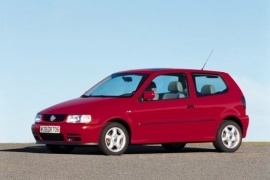
The Polo nameplate had been around ever since 1975 and was sold worldwide in a hatchback, sedan or estate version.
The third generation Polo or the Mark III was unveiled to the public in 1994 and was a completely new model built on an all-new platform shared with the Seat Ibiza. Thew new platform used the previous generation’s floorpan and many other mechanical parts.
While the then-new Polo had a similar dashboard, as well as the same powertrain options as the Ibiza, the two never shared any body panels.
For 1995, the Polo could be equipped with an all-new 1.0-liter gasoline engine that was added to the range. Other engines available were a 1.3-liter, a 1.4-liter, a 1.6-liter all gasoline and a 1.9-liter diesel unit. Power ranged between 44 hp developed by the 1.0-liter unit to 99 hp with the Classic and Variant models.
At first, the Polo was available as a three-door or a five-door hatchback, however, the sedan and the estate versions was later introduced.
Much better equipped than its predecessor, the new Polo featured body color bumpers, heated power mirrors, pollen filters, central locking, fog lights, alloy wheels, airbags and head restrains.
Four trim levels were available at first, the base L, the CL, the GL and the range topping GLX. However, the trim levels were different depending on the market.
The third generation Polo was later replaced at the end of 2001, however, the saloon and the estate models were kept in production until 2003.

Just one month after the production of the Polo 1 ended, the Polo 2 was released to the public.
It featured a new design, that combined the hatchback with a station wagon. But that wasn’t all.
The second generation was available in more body shapes such as the “squareback”, which combined a coupe with a station-wagon, a coupe with raked C-pillars, and a sedan with two doors named Derby. It was offered in three trim levels and the top-spec CL and GL featured a drivetrain carried-over from the first generation.
In 1990, a major facelift, named 2F Polo, was launched on the market. The car was completely overhauled and featured new headlights and a new interior with a dashboard design inspired by the larger Passat. It was the first time when the Polo received power brakes.
The interior started with simple cloth in a single color and black dashboard. For the CL and GL trim levels, there was a different type of upholstery and a blue dashboard. The car featured a stereo and a side rear-view mirror.
In 1981, Polo was equipped with small, 1- and 1.1-liter engines. Later on, the car was fitted with bigger units. The sportiest version was the Polo GTG40 that featured a supercharged 1.3-liter engine that boosted out up to 115 hp. It was the fastest car of its size on the market, obtaining a world record of 129 mph (207.6 kph) over 24 h. The last series 2F Polo rolled out of the factory lanes at Pamplona in August 1994.
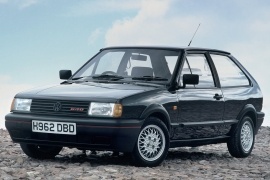
Volkswagen introduced a facelift for the second generation of the Polo in 1990, and besides the three-door hatchback and the sedan, it offered a sportier-looking version named Polo Coupe.
The Polo was already an old model. It was on the market since 1981, and the carmaker didn’t show an actual intention to change it. Still, it had enough resources to make it a better car. Along the way, it lost the slim bumpers and gained fuel-injected and supercharged engines.
For the 1990 facelift, the carmaker dropped the round headlights for the Polo Coupe. A pair of squared headlamps replaced them, and the entire front fascia got rounded edges. The black slated grille remained in place with a chromed VW badge on it. A wrapped-around plastic bumper extended downwards into an apron enhanced the car’s look. For a specific version, the carmaker added flared wheel-arches. In the back, the kammback design with a raked-forward rear windscreen and C-pillars made the little Polo looks sportier.
Inside, the carmaker kept the angular look of the dashboard, with a flat area in front of the passenger side and a small instrument cluster raised in front of the driver. A two-spoke steering wheel was standard, while a three-spoke was on the options list. The instrument panel featured two large dials for a clock and a speedometer with two gauges for the coolant temperature and the fuel level. As an option or standard for the upper trim levels, Volkswagen installed a tachometer. The cabin provided enough room for two occupants at the front and limited for two in the back. Still, for short trips, those were just fine.
Under the hood, the Polo Coupe offered a choice of gasoline engines ranged between 45 hp and 113 hp. The latter was known as the Polo G40 and featured a 1.3-liter supercharged engine.
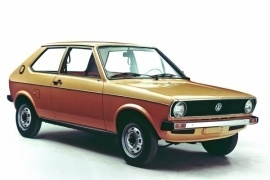
Four years after the Golf’s first-generation launch, Volkswagen introduced a smaller sibling for it, the Polo.
The badge engineering was uncommon in the ’70s, but Volkswagen did it with the first Polo generation, a re-badged Audi 50. Unlike its sibling, which never got good sales numbers, the Golf’s smaller brother was a winner since day one. Its simple appearance and small sizes made it an ideal competitor for the Italian and French cars, which mainly were the kings of the small segment.
Volkswagen said that the Bertone Design Studio was involved in the design process, but its contribution was smaller. Unlike the Golf, which Giugiaro designed, the little Polo received just a few touches here and there from Bertone. Its two-box, hatchback bodywork resembled, somehow, its bigger brother look. The round headlights and the black plastic grille with horizontal slats were similar. It was launched only as a three-door vehicle. Later on, Volkswagen introduced new body shapes.
Inside, the design was bland, with a straightforward dashboard design, interrupted by a pair of vents in the middle. Underneath it, the carmaker added a shelf that covered the entire car’s width. The instrument panel was as simple as possible, with only a speedometer and a fuel-level gauge. For other important information such as coolant-temperature or oil pressure, Volkswagen relied on warning lights. The interior featured a pair of seats at the front and a folding bench in the rear. It was good enough for four adults.
Under the hood, the German carmaker introduced the Polo with a 1.1-liter engine. Later on, it added a 0.9-liter and a 1.3-liter engine. All versions were paired to a four-speed manual gearbox.























































